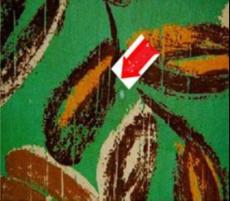GARMENTS & TEXTILES | As the demand for inspections in the garment & textile industry has increased dramatically within new sourcing destinations such as India, Vietnam, Malaysia, our inspectors on the ground have had the opportunity to generate quality statistics from the most common garment defects that have been found while inspecting at garments' suppliers in these countries.
Defect | Photo | Causes | Solution |
1. Shade variation
|  | • Variations in the production process in terms of time and speed (such as dye process) • Wrong pile direction (for corduroy, velvet and polar fleece) • Mixing fabrics used in manufacturing • Incorrect trimming, bundling and / or numbering. | Using the same base material and parameter set for each production batch can effectively prevent a change in shade. When visiting a factory that produces raw fabrics, it is very important to make sure that workers combine clothes of the same color. Proper numbering of textile types prevents the erroneous combination of cuts that differ in shade. |
2. Dirt/ stains
|  | • Textiles can never be truly protected from stains because it can appear at any time during or after production if it is not stored in an area with adequate protection. • Stains can appear on fabrics from almost any source: dirt from the plant, oil from sewing machine and dyes. • Stains are relatively easy to identify and prevent if suppliers keep a close eye on the quality of fabric. | A manufacturer can prevent stains during production by regularly cleaning production machines and equipment to ensure no random oils, grease or dyes make their way onto the textile. Wrapping the finished rolls of fabric in plastic and storing them in a separate area away from the dying area can ensure avoiding post-production stains. |
3. Uneven dyeing/ printing/ dye marks |  | • Poor quality base fabric (dirty or fly yarn on the fabric surface before dyeing).
• Dyeing machine entanglement (dirty fall on the fabric when printing). | Ensure the cleanness of fabric before dyeing or printing
|
4. Drop stitches
|  | One needle is break or cannot work normally when knitting
| Use high-quality needles on the knitting machine
Checking the yarn holder and any other machines for proper tension during production can prevent stitches from falling.
|
5. Misprinting, off printing or absence of printing
|  | Printing plate is dislocation or fabric isn’t fixed when printing.
| The printing plate and fabric must fix when printing.
|
6. Crease marks
|  | The flap assembling of two fabric pieces is imperfect (twist effect).
The press teeth of sewing machine is too tight.
| Improve the worker’s skills, and adjust press teeth.
|
7. Neps/ knots
|  | Fly fiber was fall on the yarn when spinning. Or untrimmed coarse yarn when weaving.
| Ensure proper maintenance and cleaning of machines and production environment.
Neps can be removed before processing.
|
8. Holes
|  | • Caused by an accidental cut or tear.
• Broken needles or coarse mechanical parts are common causes in tearing during production. | Ensuring that the supplier has procedures for regularly checking needles and Ensuring that scissors are not abused. |
9. Needle lines
|  | Due to unskilled workers.
| If the needle lines are found, it is recommended to only trace the needle line to the corresponding defective needle and replace it to prevent further needle lines. If needle lines appear in the strip it is recommended to replace several broken needles.
Check if your supplier has developed and maintains proper maintenance and cleaning procedures to prevent problems with needles and equipment. |
10. Broken pick
|  | A result of breaking or cutting the filling yarn, which leads to the insertion of a partial separation into the fabric.
May occur after a weft rupture, weft exhaustion, or a faulty weft fork mechanism. | Correcting weft stop motion.
Training the weaving personnel in identifying and replacing a broken piece during production can help prevent this defect from appearing in the finished product. |
Regardless of how you use the fabric and for which market segment, a clear understanding of the different types of fabric defects will help you to prevent them. The main goal of any buyer is to ensure the quality of the fabric that meets their standards, thus, it helps to study how to identify various defects of the fabric and their causes.
Before production, consider setting tolerances for fabric quality defects in your quality control checklist. Check with the supplier for a mutual system for identifying and classifying the defects, which will help to avoid potential disputes with a factory.
If you want to avoid quality complaints and product returns, along with studying the quality system and potential defects, it is also an option to turn to a third-party inspection company. QCANT conducts plenty of inspections for textiles and fabrics, as well as for finished clothes, in China, India, Vietnam and Malaysia. Full-time trained inspectors guarantee reliable professional inspection for your products while conducting specific on-site tests to ensure the long-term quality of the goods and ultimately your reputation.
https://www.qcant.com/sample-reports